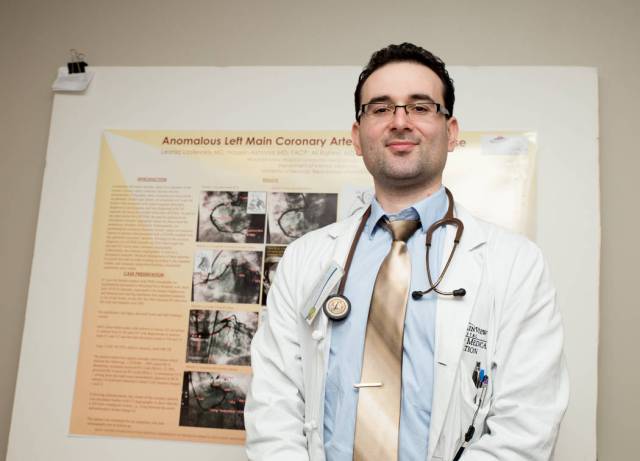
Southern Nevada needs doctors, and the next prospective wave undergoing residency training here is being celebrated by the medical community.
More than 30 residents and fellows from hospitals across the valley got to show some of what they’ve learned in the first annual research poster contest held Feb. 27 at MountainView Hospital. In the event, sponsored by the Clark County Medical Society, residents gave one-minute presentations and had display boards that dealt with a range of clinical research from treating burn wounds to dealing with malignancies.
“It’s about stimulating the academic community and getting residents and faculty together in the first step of collaborative work,” said Andrew Eisen, chief academic officer for Valley Health System and past president of the Clark County Medical Society. “We all have important work in training residents and fellows and developing more of these programs so we can address the physician workforce shortage in Nevada. One of the things we’re recognizing is creating a culture where we can work together.”
In the 2015 state budget, $10 million was set aside for creating residencies in the state. A similar amount is set aside in the 2017 proposed budget, officials said.
Residency programs are growing. Valley has an existing program with 80 residents and is adding more than 300 residents in the future with a target of July 2018 to bring more on board, Eisen said.
Nevada has a long way to catch up to what other states are doing, Eisen said. While many have 40 residents per 100,000 people, Nevada has somewhere between 12 and 14 per 100,000, he said.
That comes as the UNLV School of Medicine opens its doors in July, and Roseman University is moving ahead with its plans to open its medical school by 2019.
“If you train medical students and don’t have the residency programs, they have to go elsewhere, and they often don’t come back,” Eisen said. “There’s better than an 80 percent chance if you do your medical school and residency in the same place, you will stay here.”
In a 2014 report by the Office of Statewide Initiatives of the 3,279 actively licensed physicians in Clark County under the Nevada State Board of Medical Examiners, only 96 doctors, or 2.9 percent, did their undergraduate medical training and residency training in Nevada.
The nationwide ratio of residents to medical students is 1.2 to 1, Eisen said. Nevada is 0.5 to 1, which means the state needs another 600 more residents without accounting for the new medical schools coming online, he said.
Setting up the infrastructure of residency programs is vital to not only fix the problem of a physician shortage but preventing it from happening again, Eisen said.
“It’s not inexpensive,” Eisen said. “Just employing residents for three to five years and have the faculty to teach them and staff to support operations costs a lot. The $10 million (in state funding) is helpful, but it doesn’t pay for starting those programs. Anything they can contribute helps, and I think it’s important for people to know we are building these residency programs right here at home.”
The state funds pay for the space and faculty, and hospitals and Center for Medicare and Medicaid services cover about 50 percent of the cost of the residents, officials said. It costs more than $2 million to start new programs, and hospitals in the past haven’t had money to launch residencies on their own, officials said.
Last summer, MountainView Hospital, an HCA facility, launched a class with 52 residents comprised of 38 for internal medicine and 14 for general surgery. And its program is growing to add even more residents at MountainView.
The medical society event was held in a newly opened 80,000-square-foot, four-story medical office building where the program will operate.
“We have 15 or so programs planned for (graduate medical education) and today is about bringing the community together and celebrating residents training here at MountainView and other places,” said Dr. Darren Swenson, MountainView’s vice president of graduate medical education for Far West division of HCA that includes California and Nevada. “If we want to train these doctors, we have to first recognize them and celebrate them and the great work they’re doing.”
Among those residents was Emanuel Shapera, a third-year surgical resident at MountainView who came to Las Vegas from the University of New Mexico. The 28-year-old Shapera has two more years of residency and wants to do a fellowship to further advance his training as a surgeon, possibly in emergency care and trauma.
Shapera did a clinical presentation on burn wounds and skin grafts and comparing options on how to address the wounds to keep them from getting infected.
Shapera said he came to Las Vegas because of the opportunity offered by the new residency program and hopes to stay in the community if a fellowship is available for him once he completes his residency.
“I will stay if it will improve my education,” Shapera said. “My priority is to make myself a better physician.”
The residency programs will help keep doctors in Southern Nevada, Shapera said, because once people get settled into a place with their lives they are more willing to stay.
“It’s good for the state and patients because they will have more physicians taking care of them,” Shapera said.